The Edublog Awards
It is again time for the Edublog Awards.
I have a nomination for the best individual blog Sultan Zeydan’s Blog.
Happy blogging…!
It is again time for the Edublog Awards.
I have a nomination for the best individual blog Sultan Zeydan’s Blog.
Happy blogging…!
Dear Colleagues out there…
I would like to wish you a happy teachers’ day.
There are many good reasons to become a teacher . To begin with you get to work in a very strong & collaborative network of other teachers and become the part of a great team in my opinion no other work is more inspirational.
Aren’t you glad that you have become a teacher?
I made it!!!!
Before I talk about my experience let me give an overview of the event.
What is Global Education 2011?
2011 Global Education is a free, virtual, one week-long collaborative conference with more than 250 sessions and keynote which address mainly K-20 educators, students and other stakeholders interested in global education. It is held on the Blackboard Collaborate platform in the International Education Week (November 14-18, 2011) online and around the clock. Many people work to carry out a truly inspirational event. Of course with such a synergy coming from all over the world, there are many ideas that inspire action in our global world. Many ideas are presented, numerous instructional examples, and projects are shared. Moreover, all sessions are recorded and ready for perusal of the other parties who were not able to attend them real time.
Asli’s Giant Step
I gave myself a pat on the shoulder! Well done… It was the first time that I gave a virtual presentation using the Blackboard with real participants from and countries around the globe including Africa and China among many others. It was not perfect and error free but I learned a lot. Before the session I followed the guidelines that the Global Education initiative had prepared for the presenters, carried out some rehearsal hands on tasks and tried to familiarise myself with the Blackboard applications. Knowing that there would be a help lounge and a moderator who will help me during the presentation comforted me but being a digital immigrant in many aspects, still I was excited.
But being able to share ideas and interact with other colleagues was a great the experience.
At my presentation, I was very happy to have the opportunity to talk about building project partnerships with other colleagues who attended the session. I was sitting in my living room and talking to & with people all around the world. I was afraid of one part of the session where I asked for participants’ suggestions because I am used to traditional and face to face workshops but how would this work virtually? But participants responded and interacted. Yes the modality changed but human touch was there! I can’t tell you how happy I was when people suggested a variety of ideas.
Such a unique opportunity to talk about the creative and motivating work that our students did… and it reminded me the power of our (educators’) international network. Thanks a lot for everyone who organised and participated in the event.
Yesterday I had an interesting dream: I was trying to carry a school bag that is at least 10 times bigger that its original size (Originally it was as big as I was!). Sweating, trying real hard to lift it and put it on my shoulder and carry it onwards…. Today is my first day at school. I worked hard to prepare myself and adapt to it. (The reader should not think that I dislike teaching. On the contrary…! But long warm summer days are over and all teachers would agree with me that a transition period and collegial support are needed between sun-beach-holiday trilogy and classroom teaching.
I am Back to Blogging
I haven’t written a single thing since I started my summer holiday and I thought that this day is the day for new beginnings (at least in terms of tecahing and blogging- still not for dieting unfortunately :))
Looking forward to meeting my new students…
Today I will meet my new students (who are elementary English language learners) and I wanted to say “hello” and break the ice with interesting and fun activities. Therefore, I prepared a short movie to demonstrate some teaching points including “introducing one’s self, verb to be and some adjectives”. First I asked my friends to help me by posing and we had our photos taken. Then I used The Big Hue Labs and add a caption on each photo by using the “Captioner”My short Movie for my new students: Greeting each other feature. Finally I transferred all the photos with captions on the windows movie-maker (which is a free to download program and recorded our voice. Thanks to everyone involved, I hope that my students will enjoy our first class today. (Wish me Luck :))
I know that there are many teachers out there who are starting a brand new academic year. Have a successful and fun academic year.
What are your favourite first day activities? If you have some interesting ice-breakers and warmers please let us know.
I had been staring at the earlier e-mails from Teachers Challange blog (which gave me all the input, inspiration and courage to set up my own blog) and trying find excuses in order not to join to the challenge of building Personal Learning Network and do the tasks. I did not respond and I let the tasks (learning opportunity) go by. I said to myself; “Common, you are teaching in the summer school”, “what? are you crazy?? you are overloaded!” but after the 4th e-mail I could’t resist the temptation. I know I am behind posting but I feel very curious and I have a great desire to learn about PLN. I want to know:
1) How can PLN help me in teaching Enlish to university level students?
2) How can PLN benefit teachers’ professional development?
Looking forward to exploring the asnwers to my questions…
(Photo by Sue Water under the generic lisence of Creative Commons 2.0)
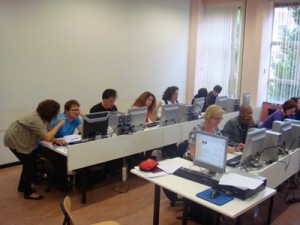 My metaphor for using ICT in class is a theme park. I feel that it is very enjoyable and exciting but at the same time it has its own ups and downs and challenges. I asked the group (who were coming to Hoge School in the evening) about their metaphors and there were very creative response. For instance for Laila, the mental picture representing ICT is:
My metaphor for using ICT in class is a theme park. I feel that it is very enjoyable and exciting but at the same time it has its own ups and downs and challenges. I asked the group (who were coming to Hoge School in the evening) about their metaphors and there were very creative response. For instance for Laila, the mental picture representing ICT is:
 She says “to use Computer Technology effectively you have to have a lot of patience and plough through the process to get a beautiful result or achieve learning” I totally agree with the effort one has to put in to blend ICT into teaching-learning.
She says “to use Computer Technology effectively you have to have a lot of patience and plough through the process to get a beautiful result or achieve learning” I totally agree with the effort one has to put in to blend ICT into teaching-learning.
For Natalie it is “an empty room which could use some furniture”, and she further comments that “but I lack a good interior designer”. In fact in my opinion this comment underlies the most important aspect that should be taken into consideration when using ICT in ELT: Information communication technology in education is not a magic wand and it is not enough on on its own to make a difference.
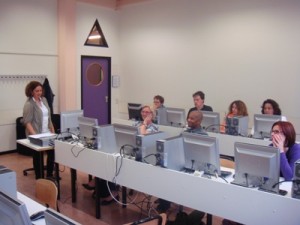 Teachers bring a particular understanding of methodology, content knowledge and practical know how and the needs of their learners to the creation of suitable activities. In this vein, it can also be concluded that students and teachers need (training in) digital literacy skills to be able to blend ICT with learning English language.
Teachers bring a particular understanding of methodology, content knowledge and practical know how and the needs of their learners to the creation of suitable activities. In this vein, it can also be concluded that students and teachers need (training in) digital literacy skills to be able to blend ICT with learning English language.
In this workshop we looked at some of the Web 2.0 tools for making your own picture (such as Photofunia & Big Hue Labs), mind mapping tools (BubbleUs & Text2Mindmap), word clouds and wall wisher. Most importantly we talked about how to use these tools for English language teaching.
Some Suggestions:
1. Using mindmaps to: Introducing vocabulary & collocations, helping students with writing skills, e.g brainstroming a visual representation, summarising the learning point of the lesson e.g. function and use of present perfect tense, settign expectations at the beginning of tecahing…etc.
For instance I asked the students at the beginning of our tecahing module to make wishes for themselves, for their classmates and for our school. My aim was to aid them set expectations. I also told them that at the end of the module (8 weeks later) we would check out these wishes to see whether they came true or not (we also revisited these to talk about what should be done to achieve these wishes).![mindmap[1] mindmap[1]](https://aslisaglam.edublogs.org/files/2011/06/mindmap1-19rft90-300x268.jpg)
2. Using wall wisher to: get feedback.
For instance for this series of workshop I used wallwisher as a device to get feedback.
Here is my interactive wall for the participnats to jot down their ideas.
For more ideas check out this link.
It was a very nice session with high level of participation (no one gave up doing the tasks despite some technical difficulties, many creative suggestions) lots of intriguing questions and creative ideas. I really love being a tecaher because I feel that our community is very supportive and we learn a lot from each other. Many thanks for the opportunity once more….!
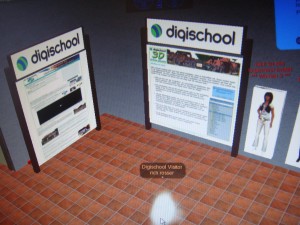 Language Village is a speaking exam which can be implemented in real-time and virtually by making use of second. I learned about it in Rotterdam thanks to Richard Rossner who kindly answered all my questions, took me to a virtual tour of the testing venue and showed the reports that are written by the assessors afterwards.
Language Village is a speaking exam which can be implemented in real-time and virtually by making use of second. I learned about it in Rotterdam thanks to Richard Rossner who kindly answered all my questions, took me to a virtual tour of the testing venue and showed the reports that are written by the assessors afterwards.
What is the principle behind Chatterdale- Language Village speaking exam? How is it administered?
According to Richard the need for an authentic speaking test stemmed from the real life skills that students are bound to carry out as well as the attempt to cater for exam anxiety. In addition, in contrast to traditional speaking tests which often require a lot of time, in Language village multiple number of students are assessed simultaneously when it is administered in real time. In an exam room, different stations are located with teachers and qualified staff who act as assessors. So think about a room which has a green grocer, a doctor, a railway station, a police station and a bank. Test takers are given passports and are instructed to visit each and every station, carry out the task they are required, e.g. greeting people, buying apples, opening a bank account…etc. Upon completion of all required tasks and talking to assessors that are playing out their roles as a clerk or sales person, test takers submit their passport. Unlike some traditional standardised tests students do not work in pairs they talk to assessors one on one.
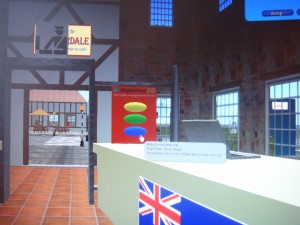 As for the virtual version of the test, the test taker logs in at a certain time that is notified to him earlier and chooses an avatar for her. Assessors also log in and guide the test takers by giving instructions (e.g. go to the police station and do this specific task). I put on my headphones that had a mike and did a simulation of Language Village with Richard. It was really enjoyable to move around a virtual town and try to follow the instructions. It was like a computer game, very enjoyable.
As for the virtual version of the test, the test taker logs in at a certain time that is notified to him earlier and chooses an avatar for her. Assessors also log in and guide the test takers by giving instructions (e.g. go to the police station and do this specific task). I put on my headphones that had a mike and did a simulation of Language Village with Richard. It was really enjoyable to move around a virtual town and try to follow the instructions. It was like a computer game, very enjoyable.
Content of the Test
It changes according to schools. For instance for vocational schools such a s tourism or car mechanics stations change from grocery to a complaints table, and a city council table.
How are the grades assessed?
Basically, each assessor puts down his/her grade and at the end the average is taken
Who are the assessors?
Teachers and students of Hoge School who are training to be teachers are collaboratively working as assessors. For pre-service teachers participating in language village is a part of their pro0gram and they get credits for this. Also they are introduced to their future work environments and have chances for networking. They are also asked to submit a report regarding stages of the test, their reflection and evaluation of it. Richard also stated that host schools also at times ask their older students to act as interlocutors for the younger ones.
Who are the test takers and how do they respond to the test?
Candidates are ranging between 13-18 and they come from a variety of schools `says Richard. He also told me that he has seen very competent and confident students who seemed to enjoy taking the test as well as students who were on the brink of a nervous breakdown because of their exam anxiety. There are Time Out rooms in which students can rest for some time and are attended by counsellors Richard explained.
What kind of criteria is used and how do you deal with standardisation?
Richard told me that one of the biggest challenges is setting up a team of assessors and this was leading to some reliability issues including inter and intra assessor reliability. Therefore he believes that it is very important to build an ongoing support and training for the staff of the speaking test. Right now there is not a clear cut criterion. Assessors have a meeting before the exam and discuss the benchmarks and the points to be focused on.
Although real-time version of the exam has been given for a long time the virtual version is in its infancy but I really thought that it has great potential. We even dreamed about having a joint project in which Dutch students and Turkish students would test speaking skills of each other!
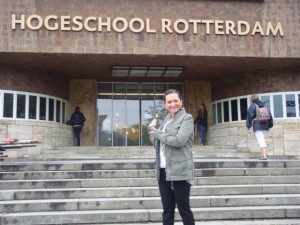 I am in Rotterdam! Such a nice city… I am here because I am participating in ERASMUS teacher mobility program and I will (am) delivering series of workshops about ICT in English language classes.
I am in Rotterdam! Such a nice city… I am here because I am participating in ERASMUS teacher mobility program and I will (am) delivering series of workshops about ICT in English language classes.
 So today I met Francis who is my contact person in Hoge School very early in the morning and we went to the venue. Hoge School is such a learner friendly instituton with high tech facilities, cosy & large libraries, spacious classes, and lots of study halls. I loved the place! The partipants were 3rd year students training to be English language teachers. (Here pre-service training starts right form the beginning in the freshman year. Students observe actual classes. Then they start their practicum in borrowed classes as of their second year and they have assessed teaching in the 3rd year. This system sounds ideal because it aims to bridge the gap between theory and practice).
So today I met Francis who is my contact person in Hoge School very early in the morning and we went to the venue. Hoge School is such a learner friendly instituton with high tech facilities, cosy & large libraries, spacious classes, and lots of study halls. I loved the place! The partipants were 3rd year students training to be English language teachers. (Here pre-service training starts right form the beginning in the freshman year. Students observe actual classes. Then they start their practicum in borrowed classes as of their second year and they have assessed teaching in the 3rd year. This system sounds ideal because it aims to bridge the gap between theory and practice).
Francis told me that he has a wiki page that his students work collaboratively and therefore I decided to upload the content of the workshop on a wiki page and conduct some parts of the session by using this wiki page.
I really enjoyed being infront of an international and multicultural audience. It was very exciting and I hope that nobody heard the pounding of myheart (because it was :)) We looked at some Web 2.0 tools including podcasts, wikis, blogs, tools to create your picture, mind maps and wall wisher. Actually they kindly wrote their feedback about the session by using an interactive wall here.
There is another session tomorrow in the evening this time for people who work and study at the same time. Until then I will discover the city. Museums, art galeries, restaurants and toy shops (for my Little Prince Mirza) wait for me!!!
“Why do we have walls?” asked Laura. We were having our seventh session in “Train the Trainer” program on a coldish May night and my mind was busy with classroom management problems I was having. Then with this question echoing in my mind, I had a parade of walls; walls of every kind and color marching infront of my eyes. Then all together we brainstormed on the question “why we have walls”. For protection, isolation, decoration…? What ever the reason is sometimes because of psychological, socio-psychologiacl and socio-physical environmental reasons we build walls to learning and teaching. Then when everyone builds tall walls around themselves no one can reach each other.Think about yourself when you have class management problems, resistant students, resistant colleagues in a workshop or training. I really think that problems can be solved better and more efficiently if we can see the real person behind and confined within those walls.
What can be done to break down the walls?
Understanding the reason(s) that lead to walls (getting to know people, spending time with them)
Being open and transparent (sharing your ideas &fears sincerely)
Tolerance, trust and forgiveness instead of reacting immediately and accusation
Active listening & observation
Accepting your mistakes and apologising when you have a mistake and communicating the message that apologising is a virtue.
Using a variety of methods to foster enthusiasm and motivation
Explaining the lesson/ session/ workshop/ training objectives and aims
I really enjoyed talking about resistance, common and doing th activity in which we heard about most frequently raised statements reflecting people’s resistance such as “it won’t work in our department, we have always done it this way and no one has complained, and we tried that once more and it did not work” and try to find solutions to handle the resistance.
It would be lovely to hear about other voices. How do you handle resistance? What are your classroom management strategies and tactics?
Recent Comments